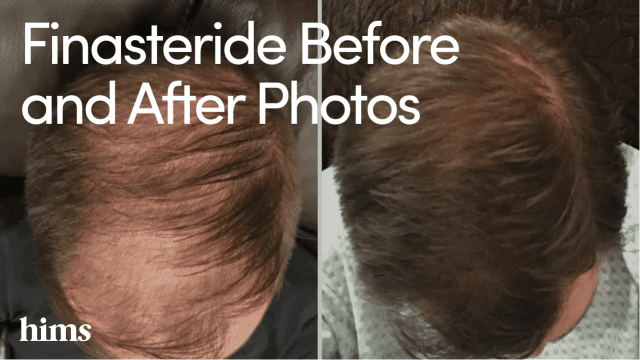
Before you begin using a prescription medication -- or any type of treatment, for that matter -- it makes sense to do your research and determine if it’s the right choice for you.
In the case of male pattern baldness treatments like finasteride, there’s nothing more telling than before and after photos.
Before and after photos of any endeavor, from hair growth to weight loss, give you a convenient way to view the fruits of many weeks or months of work. After all, nothing shows progress like a series of photos, each with thicker hair and less visible balding.
Below, we've explained what finasteride is, as well as what you can expect if you use finasteride to treat male pattern baldness.
We’ve also shared some before and after photos to show what finasteride can potentially do, as well as detailed instructions to help you take your own progress photos while using finasteride to treat hair loss.
What to Expect With Finasteride Results
Finasteride is a 5-alpha reductase inhibitor, a medication that prevents the hormones associated with from damaging your hair follicles.
While FDA-approved finasteride starts reducing levels of the hormone right away, it can take several months before you’ll be able to see changes in your hairline and overall hair density. In other words, don’t expect immediate results like you would with a hair transplant or hair restoration.
But provided you take finasteride consistently, you can rest assured that it is working. The medication immediately starts blocking the conversion of testosterone to DHT, even if the is a little longer.
When used properly, finasteride is generally highly effective at protecting your existing hair and stimulating hair regrowth.
A long-term study carried out in Japan tracked 532 men affected by androgenetic alopecia. The men were prescribed finasteride for 10 years in total, with researchers assessing their hair growth and prevention of further hair loss. The results of these clinical trials: After using finasteride for 10 years, 99.1 percent of the men displayed a prevention of hair loss progression, with 91.5 percent also showing improvements in hair growth and coverage.
These findings suggest that finasteride treatment isn’t just effective at stopping hair loss during the first year or two — it remains effective as a treatment option for hair loss over the long term, too.
3 Months Finasteride Before and After Results
Finasteride usually requires some time to produce new hair growth, meaning you may not see huge results after three months. However, for many men, mild improvements in hair coverage may start to become visible around the three-month mark, and some men may see these results even earlier, depending on unique responses to the medication.
6 Months Finasteride Before and After Photos
After taking finasteride for at least six months, most men should see a slowing of hair loss, and possibly a small degree of hair regrowth. Keep in mind that it usually takes longer than six months to see the full benefits of finasteride, meaning any results at this point aren’t yet final.
12 Months Finasteride Before and After Photos
Most men with hair loss notice the effects of finasteride after 12 months, whether this means a significant amount of hair growth or a slowing of hair loss. Try comparing your 12-month photo to one taken before you started finasteride to accurately assess your progress.
Will you join thousands of happy customers?
4.5 average rating
How to Take Your Own Before and After Finasteride Photos
If you currently use finasteride to treat hair loss, or if you’re considering using finasteride to deal with a or thinning hair, one of the best ways to track your hair growth progress is by taking regular photos of your hairline and scalp. These photos will provide an easy way to measure your progress and see how well finasteride is working for you.
Taking your own before and after photos isn’t too difficult, but there are a few things you’ll want to keep in mind before you get started:
Choose a room with bright (but not too bright) lighting. It’s important to have clear, reasonably bright lighting when you’re taking photos. This helps to give a good view of your scalp and make any bald patches or areas with thinning hair easier to see.
Photograph your hairline, scalp, and any other problem areas. For most guys, male pattern baldness affects the hairline and crown first. Make sure to take photos of these areas, as well as any others that are affected by hair loss. To make measuring your progress easier, try to take photos from the same angles. You may need to ask someone to help you to accurately capture areas with noticeable balding.
Take photos of your hairline and scalp once a month. Your hair needs time to grow, meaning there’s no reason to take photos every day. Instead, take photos on a monthly basis so that you can see a clearer difference between each one. Your first few photos may not display much progress — but keep watching.
Once you’ve built a series of monthly photos, try looking back every three to six months to see how your hair has improved. As finasteride starts to work, you may notice that your hair loss begins to slow down over time or that certain areas of your scalp gain extra hair density, thanks to increased hair thickness from added hair count.
How to Get the Most Out of Finasteride
Using finasteride is simple, but there are a few things that you can do to get the best results and reduce your risk of experiencing side effects or other issues.
First and foremost, it’s most important to keep using finasteride after you start to notice improvements in your hair growth and density. Finasteride needs to be taken on an ongoing basis to remain effective — if you stop taking it prematurely, you may start to lose the hair you’ve regrown.
Here are some other tips and techniques to help ensure you get positive results from finasteride:
Keep using finasteride as directed, even if you don’t see any improvements at first. Finasteride works, but results aren’t immediate. Make sure to take finasteride for three to six months before you assess any improvements in your hair, as it may take this long for finasteride tablets to reduce the DHT levels enough for your hair to flourish.
Use finasteride with minoxidil. Topical minoxidil, an over-the-counter hair loss medication sold as Rogaine®, is very effective when it’s used alongside finasteride. In fact, studies show that these medications are more effective when they’re used together than apart. In one study, researchers found that 94.1 percent of men with pattern hair loss who used minoxidil at the same time as finasteride showed improvements, compared to around 80 percent of men who only used finasteride.
Use a hair loss prevention shampoo. Many shampoos contain active ingredients that may help to further reduce the effects of DHT on your scalp, such as saw palmetto and ketoconazole. Our Hair Thickening Shampoo, for instance, is formulated with saw palmetto and other ingredients to target DHT while promoting volume and moisture.
Inform your healthcare provider if you develop side effects. Most people don’t have any side effects from finasteride. However, a small percentage of men who use it develop sexual side effects, such as erectile dysfunction (ED) and a reduced sex drive.
If you develop side effects while using finasteride, let your healthcare provider know as soon as you can. They may suggest adjusting your dosage or making other changes to the way you use your medication.Consider topical finasteride. If you develop side effects from oral finasteride, you may benefit from switching to topical finasteride — a form of finasteride that only reaches your bloodstream in trace amounts. Hims offers a Topical Finasteride & Minoxidil Spray, allowing you to target hair loss topically from multiple angles.
Store finasteride properly. Finasteride should be stored in its original container, closed and out of reach of children. Avoid storing finasteride in your bathroom or other spaces that are warm with excessive amounts of moisture.
Hair loss treatments, delivered
The Bottom Line on Finasteride Progress Photos
Looking at hair loss progress photos from other men can give you a solid understanding of what to expect from finasteride.
However, if you’re waiting for your hair to exhibit the same thicker hair changes as the before and after photos, keep the following in mind:
Your results from finasteride can vary based on several factors, including your genes, your habits, and the severity of your existing hair loss.
If you’ve recently started using finasteride, take your own photos on a regular basis to accurately track your progress. Over time, you may start to notice improvements in your hair, including a slowing of hair loss or even some degree of regrowth.
If you experience any side effects of finasteride, talk to a board-certified dermatologist or other dermatology expert about your concerns. They may adjust your treatment plan or suggest alternatives.
Interested in using finasteride? We offer finasteride,minoxidil, and other hair loss treatments for men online, with prescription products available following an online consultation with a licensed healthcare provider.
8 Sources
- Ho CH, et al. (2021, November 15). Androgenetic alopecia. https://www.ncbi.nlm.nih.gov/books/NBK430924/
- Hoover E, et al. (2021). Physiology, hair. https://www.ncbi.nlm.nih.gov/books/NBK499948/
- Hu R, et al. (2015). Combined treatment with oral finasteride and topical minoxidil in male androgenetic alopecia: a randomized and comparative study in Chinese patients. https://onlinelibrary.wiley.com/doi/abs/10.1111/dth.12246
- Kaufman KD, et al. (1998). Finasteride in the treatment of men with androgenetic alopecia. Finasteride male pattern hair loss study group. https://pubmed.ncbi.nlm.nih.gov/9777765/
- Propecia - finasteride tablet, film coated. (2021). Retrieved from https://www.accessdata.fda.gov/spl/data/3c8dff7e-41ab-46db-bacf-c41cc237f9d9/3c8dff7e-41ab-46db-bacf-c41cc237f9d9.xml
- U.S. National Library of Medicine. (2022). Finasteride. https://medlineplus.gov/druginfo/meds/a698016.html
- Yanagisawa M, et al. (2019). Long-term (10-year) efficacy of finasteride in 523 Japanese men with androgenetic alopecia. https://www.researchgate.net/publication/337105943_Long-term_10-year_efficacy_of_finasteride_in_523_Japanese_men_with_androgenetic_alopecia
- Zito PM, et al. (2022). Finasteride. https://www.ncbi.nlm.nih.gov/books/NBK513329/
Editorial Standards
Hims & Hers has strict sourcing guidelines to ensure our content is accurate and current. We rely on peer-reviewed studies, academic research institutions, and medical associations. We strive to use primary sources and refrain from using tertiary references. See a mistake? Let us know at blog@forhims.com!
This article is for informational purposes only and does not constitute medical advice. The information contained herein is not a substitute for and should never be relied upon for professional medical advice. Always talk to your doctor about the risks and benefits of any treatment. Learn more about our editorial standards here.
